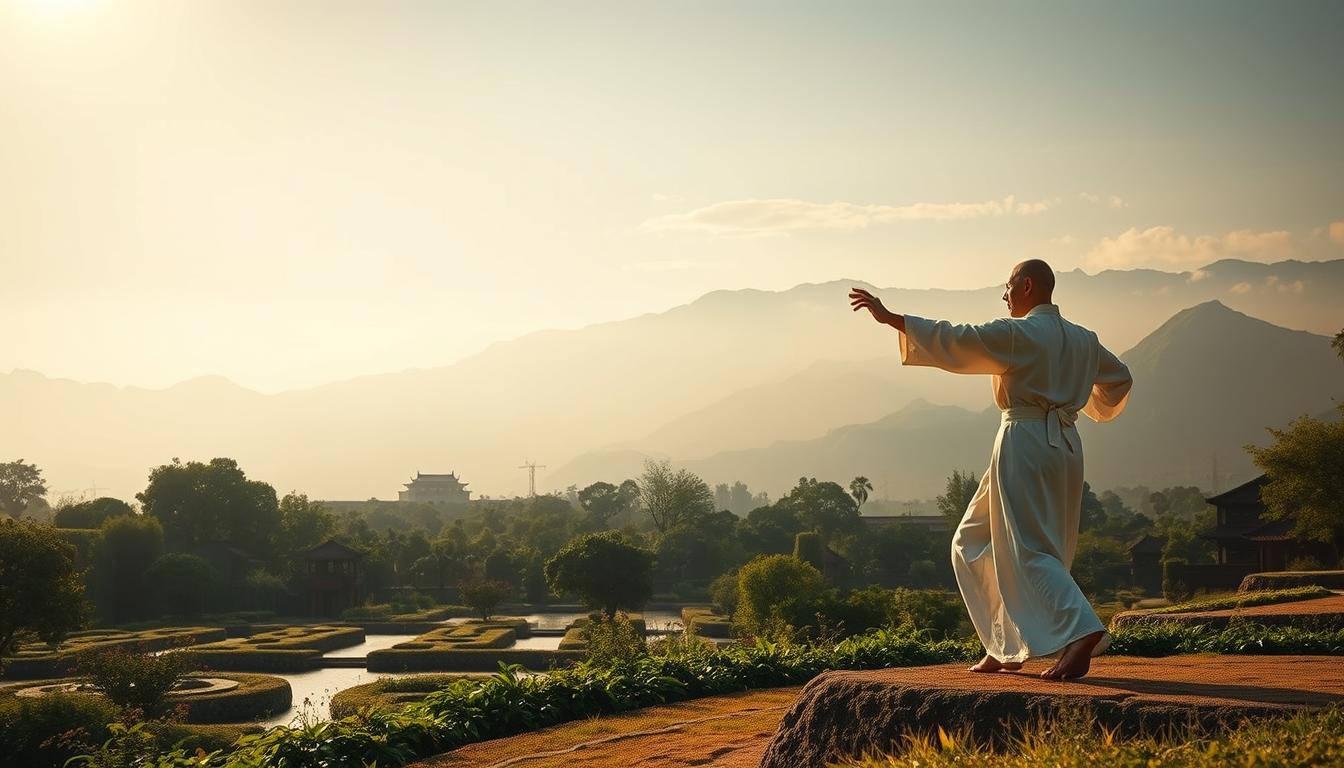Every morning, millions step onto quiet paths or open spaces. They move in slow, deliberate motions. These moments are more than exercise—they connect ancient wisdom with modern health. Tai Chi, rooted in Chinese tradition, offers a healing path that resonates in today’s fast world.
Imagine a practice that strengthens muscles, calms anxiety, and fosters balance. Tai Chi’s healing power has changed lives for generations. It blends graceful movements with mindfulness to address physical and emotional well-being. This article explores how Tai Chi’s timeless principles meet modern needs, showing that healing is simple.
Key Takeaways
- Tai Chi’s origins trace back to Chinese martial arts, now celebrated globally for its healing benefits.
- Scientific studies affirm the benefits of tai chi for improving balance, reducing stress, and boosting immunity.
- Accessible to all ages, Tai Chi uses slow, flowing movements to build strength without strain.
- Its mind-body approach aligns with principles of Traditional Chinese Medicine, focusing on energy flow (chi) for holistic wellness.
- Discover how Tai Chi’s ancient philosophy can address modern health challenges, from chronic pain to mental clarity.
Understanding the Ancient Practice of Tai Chi
Tai chi has a long history, starting as a martial art and now used for wellness. It began in the 17th century with Chen Wangting, who mixed fighting skills with Taoist ideas. Today, it focuses on tai chi healing power, aiming for health over fighting. It teaches balance, like Taoism, by blending body and mind.
The Historical Origins of Tai Chi
Tai chi started in Henan province for self-defense. By the 20th century, it became a health practice. Now, people use it to move better and feel less stressed, showing its shift to a tai chi for health approach.
Foundational Principles of Tai Chi Practice
- Slow, controlled movements to improve muscle and joint flexibility.
- Deep, rhythmic breathing to increase oxygen and calm the mind.
- Intentional focus on body position to enhance mental clarity.
These practices help activate “chi,” or life energy, boosting physical and mental strength.
How Tai Chi Differs from Other Movement Practices
Tai chi is different from yoga and Pilates because of its flowing motions. It’s low-impact, making it safe for everyone. Its focus on energy flow sets it apart from Western exercises, which often focus on strength.
“Tai chi is meditation in motion,” says Dr. Paul Lam, a global tai chi instructor. “It combines movement and mindfulness to nurture wellness.”
This makes tai chi healing power a key part of alternative health around the world.
The Tai Chi Healing Power: Scientific Evidence and Research
Recent studies show tai chi’s healing power through real results. Harvard Medical School found it lowers blood pressure, helping the heart. The Journal of the American Geriatrics Society shows older adults who practice tai chi boost their immune system. They had 47% fewer colds in one study.

- Bone density improves in postmenopausal women after 6 months of practice
- Studies show tai chi enhances brain connectivity in those over 60
- Chronic pain patients need 30% less medication after 8 weeks
“Tai chi’s slow movements create physiological changes seen in MRI scans, proving its impact on both body and brain,” said Dr. Roger Jahnke, author of The Healing Power of Qi.
Modern science explains tai chi’s benefits through neuroplasticity. This is the brain’s ability to change with movement and mindfulness. Stress hormones like cortisol decrease during tai chi, and balance improves by up to 55%.
These findings from NIH-funded trials prove tai chi is more than tradition—it’s evidence-based healing. It boosts immunity and sharpens focus. The science backs up what practitioners feel: a practice that combines ancient wisdom and modern science.
Physical Benefits of Tai Chi Practice
Benefits of tai chi are wide-ranging, from better balance to improved heart health. It’s a low-impact exercise that combines slow movements and controlled breathing. This creates a full-body workout that’s both gentle and effective.
Improved Balance and Flexibility
Tai Chi’s flowing movements, such as “Wave Hands Like Clouds,” work on stabilizer muscles often ignored in other workouts. A 2023 study in Journal of Gerontology showed a 35% drop in falls after 12 weeks. Key moves include:
- Weight shifts to strengthen ankles
- Slow turns to boost hip mobility
- Reach-and-extend postures for spine flexibility
Enhanced Cardiovascular Health
Tai Chi’s continuous motion raises heart rate without strain. A 2022 Harvard Health Publishing report found blood pressure drops of 5-7 points in regular practitioners. Benefits include:
- Improved circulation through rhythmic breathing
- Lower resting heart rate
- Stress hormone reduction
Pain Reduction and Management
Those with arthritis or fibromyalgia often find relief in Tai Chi’s gentle joint mobilization. A 2021 Pain Management study showed a 40% pain reduction. Key pain-targeted movements:
| Condition | Benefit |
|---|---|
| Arthritis | Gentle rotation of joints |
| Back Pain | Core engagement in “Single Whip” posture |
| Fibromyalgia | Relaxed muscle stretches |
Strengthening Without Strain
Isometric holds, like “White Crane Spreads Wings,” build muscle endurance without heavy weights. A 2020 Journal of Sports Sciences study found muscle strength gains similar to yoga in older adults.
These tai chi for health advantages make it a valuable holistic fitness tool. Beginners can start with 10-15 minute sessions to gradually experience these transformative effects.
Tai Chi for Mental Health: Calming the Mind
Tai chi is a great way to clear your mind and find emotional balance. It combines slow movements with deep breathing. This helps calm the mind and reduce stress.

“Participants in a 2022 study reported 40% less anxiety after 12 weeks of tai chi practice,” noted the Journal of Behavioral Medicine.
Key mental health benefits include:
- Reduced symptoms of anxiety and depression
- Improved focus and cognitive sharpness
- Better sleep patterns and energy levels
When you practice tai chi, you move through postures while focusing on your breath. This creates a meditative state. It helps your body relax and reduces stress hormones.
Health experts now suggest tai chi as a way to manage stress. You can start with short sessions and increase them as you get more comfortable. Classes or videos can help you find a routine that works for you.
The Mind-Body Connection in Tai Chi Practice
Tai Chi’s power comes from its tai chi mind-body connection. It combines physical actions with mental focus. This mix creates a powerful synergy for overall health.
By linking breath, movement, and intention, Tai Chi taps into the tai chi healing power. It works on both the body and mind at the same time.
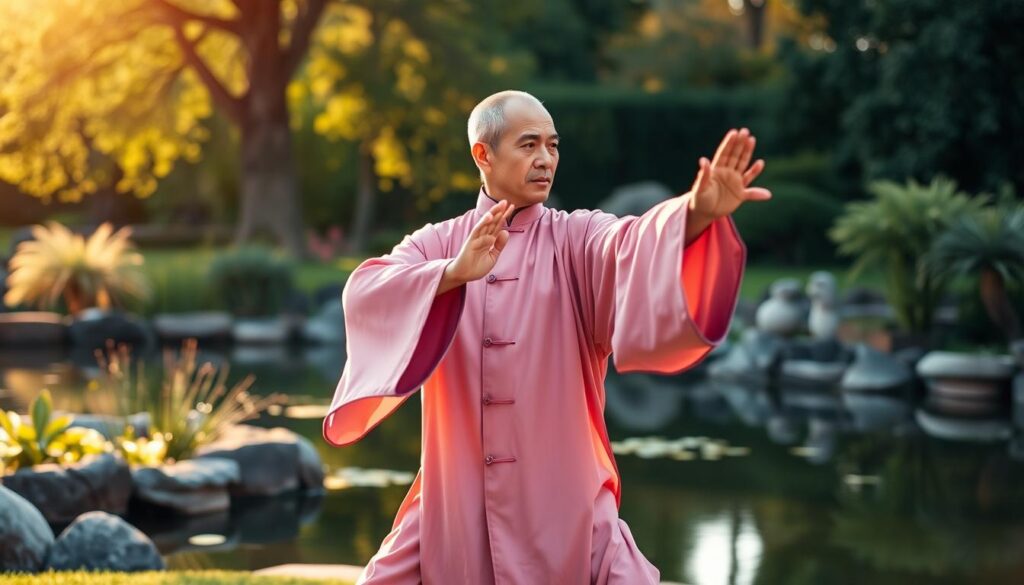
Chi Flow and Energy Cultivation
Chi, or life force, flows through our bodies. Tai Chi’s slow movements help chi flow freely. This improves nerve function and lowers stress hormones.
Mindfulness Through Movement
Each step in Tai Chi requires full attention. This practice trains the brain to stay present. It quiets thoughts and brings calm to everyday life.
Developing Body Awareness
Practitioners learn to sense small changes in their body. This awareness improves posture and balance. It also leads to healthier habits and better self-care.
Tai Chi combines movement with mindfulness for lasting wellness. The tai chi healing power is unleashed when body and mind work together. It tackles stress and pain at its source.
Tai Chi Meditation: Deepening Your Practice
Tai chi meditation combines physical movements with breath and focus. It strengthens the tai chi mind-body connection. This section will explore ways to deepen your practice.
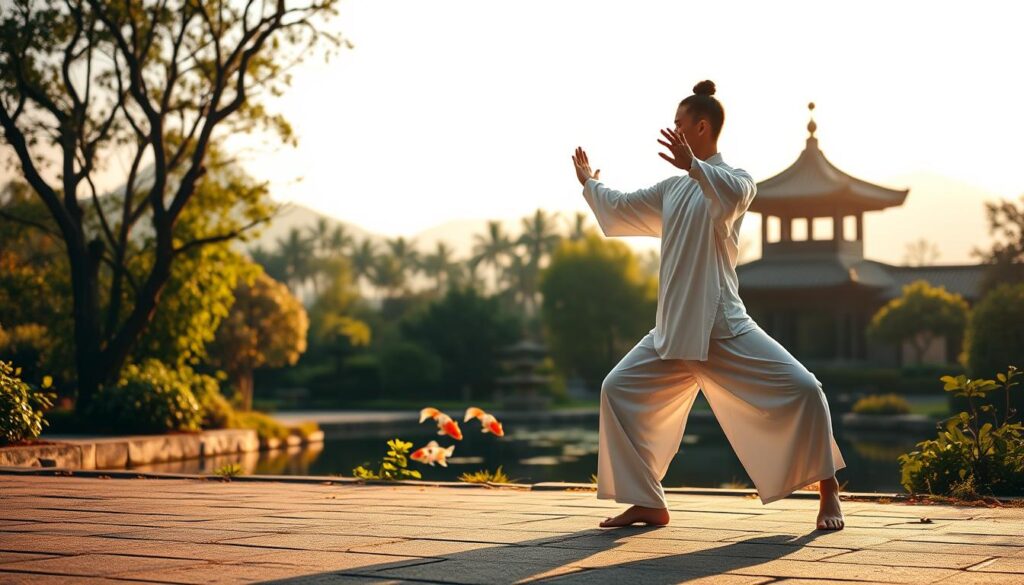
Standing Meditation (Zhan Zhuang)
Start with zhan zhuang, or “tree stance.” Stand with feet shoulder-width apart and knees slightly bent. Hold postures like “play bow” or “ward-off” for 5–10 minutes. Focus on your legs and core.
This builds rootedness and mental clarity. It aligns your posture with your breath.
Moving Meditation Techniques
Try fluid sequences like “Grasping Sparrow’s Tail.” Each motion flows smoothly, encouraging mindful body awareness. Practitioners track shifts between soft and hard postures.
This enhances present-moment awareness.
Breath Work in Tai Chi
Three key techniques boost energy flow:
- Natural breathing: Inhale/exhale with each movement phase
- Reverse breathing: Contract diaphragm on inhale for deeper core engagement
- Coordinated breath: Sync inhales/exhales with arm/leg motions
| Technique | Focus Area | Primary Benefit |
|---|---|---|
| Standing Meditation | Posture stability | Grounded energy flow |
| Fluid Movements | Body awareness | Stress reduction |
| Breath Synchronization | Oxygenation | Energy balance |
Beginners may find it hard to stay calm in standing postures. Use a wall for balance if needed. For breath work, start with slow inhales through the nose and exhales through the mouth.
Practice these techniques regularly. Over time, your tai chi meditation practice will deepen.
Tai Chi for Stress Relief in Modern Life
In today’s fast world, stress from work and technology affects our health. Tai chi offers a timeless way to fight these stressors. It helps calm the body and mind, even in busy times.
Stress makes our body release cortisol, a hormone linked to heart disease. Tai chi slows down our breathing and movements. This activates our calm system, lowering cortisol and building emotional strength. Studies show it helps us stay focused and calm, even when things get tough.
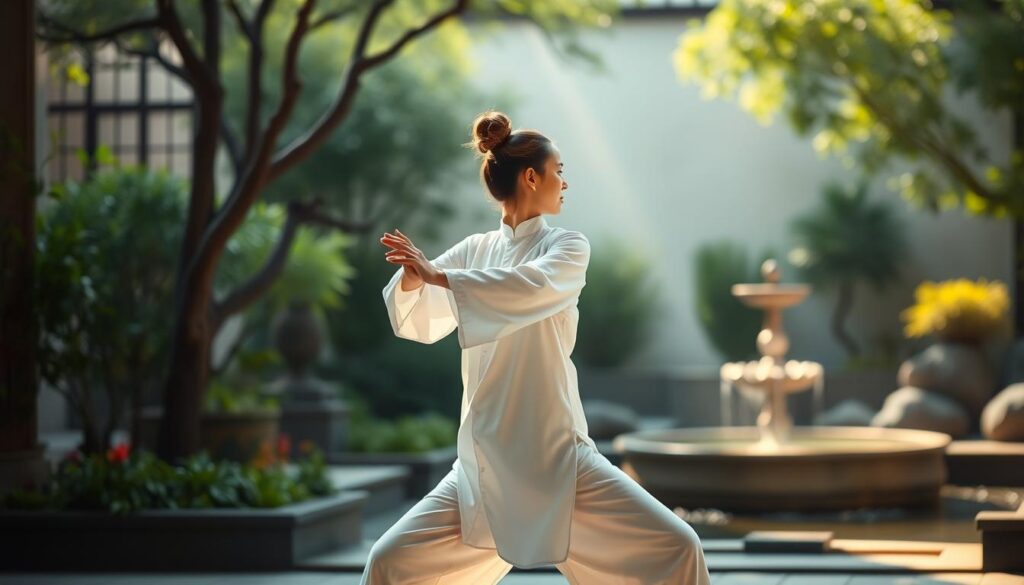
- Practice 10–15 minutes during lunch breaks to reset between tasks
- Use slow, deliberate movements to counteract screen-induced tension
- Incorporate mindful breathing techniques during commute or meetings
By making these small moments of mindfulness a part of your day, tai chi can help you balance life’s demands. It’s not about avoiding stress but building inner strength to face life’s challenges with clarity and calm.
Holistic Healing Through Tai Chi
Tai Chi’s holistic healing power shines when it’s part of a bigger wellness plan. It combines ancient movement with energy balance, tackling the source of imbalance.

Traditional Chinese Medicine views health as a balance between body, spirit, and environment. Tai Chi enhances this balance when combined with:
- Acupuncture to align meridians and stimulate chi flow
- Herbal formulas to nourish organs targeted by practice
- Dietary guidelines to sustain energy harmony
Tai Chi’s movements reflect the balance of Yin and Yang. Soft movements (Yin) blend into strong ones (Yang). This mirrors nature’s cycles, teaching us to flow with life’s ups and downs. When energy flows freely, physical pain and mental stress fade away.
Tai chi holistic healing is different from modern medicine’s piecemeal approach. It strengthens the body while calming the mind. It boosts flexibility and emotional strength. This makes it a complete system for keeping vitality throughout life.
Getting Started with Tai Chi for Health
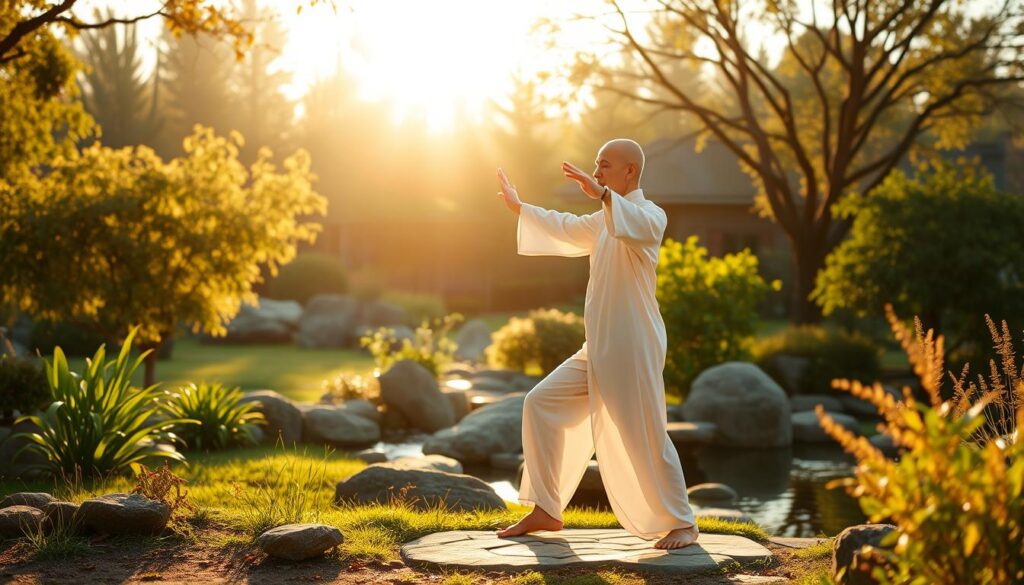
Starting tai chi for health is easy. You don’t need any special skills. This guide will help you start a practice that fits your life and goals.
| Style | Focus | Best For |
|---|---|---|
| Yang | Slow, flowing movements | Beginners seeking relaxation |
| Chen | Forceful bursts | Active individuals |
| Wu | Compact postures | Space-limited practice |
| Simplified Forms | Short sequences | Health-focused learners |
Selecting Your Practice Path
Choose a style that fits your benefits of tai chi goals. Simplified forms are great for improving joint mobility or balance. Look for classes that focus on health to get the right modifications.
Building a Routine
- Start with 10–15 minute sessions, 3x weekly
- Use quiet, uncluttered spaces to reduce distractions
- Track progress with a journal to stay motivated
“Consistency, not complexity, drives the benefits of tai chi.” – National Institute of Health
Avoiding Early Pitfalls
- Rushing movements: Prioritize form over speed
- Neglecting breath control: Inhale/exhale with each posture
- Comparing yourself to others: Progress varies individually
Even short sessions can improve balance and reduce stress. Tai chi for health is for everyone. Start today and see the benefits in weeks.
Tai Chi Therapy Applications for Specific Health Conditions
Medical studies show that tai chi therapy helps people with certain health issues. For example, Harvard Medical School’s Tai Chi for Arthritis course uses special movements to help with chronic conditions.

| Condition | Key Benefits | Practice Modifications |
|---|---|---|
| Parkinson’s Disease | Improved balance, gait stability | Slow, focused stepping exercises |
| Heart Disease | Lowered blood pressure, better circulation | Seated postures for cardiac patients |
| Osteoporosis | Bone density support | Weight-bearing hand techniques |
| Chronic Pain | Muscle relaxation, pain reduction | Shortened sequences for flexibility |
A 2023 study in the Journal of Gerontology found tai chi for health reduced falls by 47% among older adults with balance issues.
Clinical programs like the NIH-supported Moving for Health initiative tailor tai chi to fit individual needs. For diabetes, slow arm movements and deep breathing help with metabolism. Stroke survivors use simple routines to improve motor skills with a therapist’s help. Always check with a doctor before starting, but this is more important for heart conditions or recent injuries.
Using tai chi therapy along with regular treatments offers a complete approach. Medical centers like Mayo Clinic now suggest it for managing chronic pain. Customized routines ensure safety while providing well-documented benefits.
Conclusion: Embracing Tai Chi as a Lifelong Healing Practice
Tai chi combines ancient wisdom with modern health science. It heals both body and mind, helping people of all ages and abilities. It reduces stress and improves balance, adapting to each person’s needs.
Studies show tai chi helps manage chronic conditions. It also brings inner peace, as skills grow. People worldwide join classes and online groups to learn together.
Tai chi offers relief from pain and boosts mental focus. Its gentle movements are for everyone, from beginners to experts. It’s a journey to lasting well-being, growing with life’s changes.
